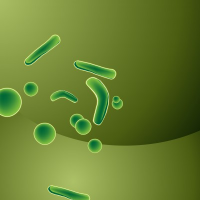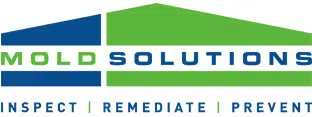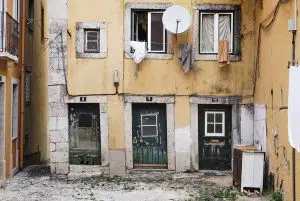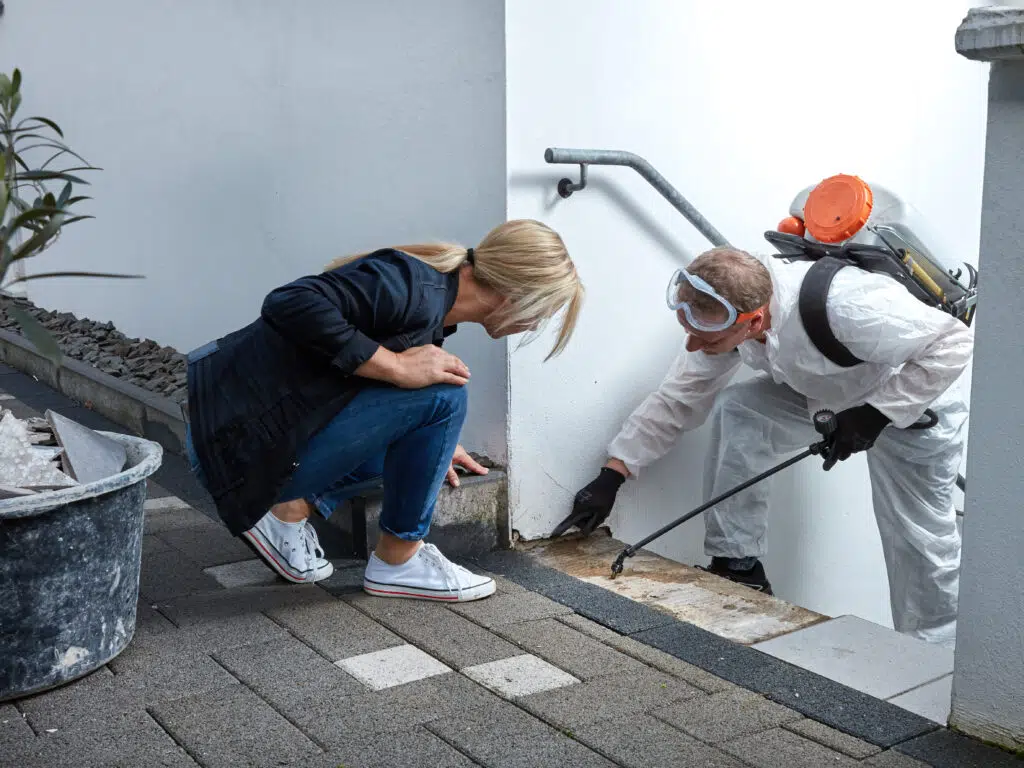Table of Contents
What Are Mold Spores?

Spores are the reproduction method for fungus and algae. Since mold is a fungus, its means of reproduction is through spores, which are asexual, and don’t need to combine with anything else in order to reproduce.
Spores are much like seeds, but are much quicker and have a higher reproduction rate. Mold spores are microscopic. So, they can float through the air and land almost anywhere.
Some molds may produce spores that can survive harsh conditions like dryness or lack of food. When conditions improve these spores will turn into mold again (kind of like seeds for plants).
Mold spores fall into two categories:
1) Some mold spores are carried by the wind.
2) Other mold spores will travel to other places on animals, insects, or people (on their skin, hair, feet).
Both types of mold spores can cause health problems in certain people.
Mold is a living organism that feeds off the nearby material which means it takes nutrients from wood, stone, drywall, etc. Molds are fungi that reproduce by making spores. Molds produce microscopic strands that can be seen with a microscope. The floating spores will enter the air and travel to different areas via air currents or on animals/people (foot traffic). They can land on surfaces such as walls, clothing, and even furniture and start to grow.
Even the slightest amount of moisture can provide a mold colony enough sustenance to start producing spores, so it is very easy for them to take hold in any enclosed area if there’s even a small leak in an appliance or home, especially with today’s more energy-efficient homes that hold in the humidity. Of course, they need a bit more than humidity to thrive, but moisture is a necessary component.
Mold needs water or high humidity to survive. Without it, they won’t be able to reproduce and spread. Mold spores also need a source of nutrition in order to grow so if you have an area that doesn’t have enough nutrients then the mold will not grow there. Moisture is the primary factor in mold growth, so if there is no moisture then there will be no mold growth. It cannot grow without any moisture at all. Even very dry places can have mold growing if there are other sources of moisture around – such as a flood or leaky pipes, etc. Mold doesn’t need a lot of water or humidity to grow. It only needs enough to allow the spores to come in contact with a moist surface and have something they can attach themselves to for support as they start to grow.
Mold is not an animal so it doesn’t need air or light to live. Mold can be found anywhere where there is moisture and food to feed on. Mold needs three things to grow: water, temperature (not too hot or cold), and food (different types of mold eat different materials). So if one of those needs is not present the mold will not start to grow. Mold doesn’t need any more than normal humidity for survival. However, spore release often happens in damp places, so you will see it more often there.
Mold needs a food source, moisture, and oxygen to grow. The good news is that if the humidity is not high enough it will die pretty quickly because without humidity mold can’t survive very long. In addition, if there’s not enough of air exchange with the outside then it can die pretty quickly. If you suspect mold in a crawl space or basement, look for standing water and for cracks in the flooring that would allow airflow to pass through under the floor.
Mold Spores In The Air
Traveling through the air, mold spores are always with us, inside and outside. If they were able to stay outside, they wouldn’t be a problem, but they enter our homes every time we open a window or a door.
Then, once they are inside, their movement and ability to spread are assisted by our activities that cause air movements, such as cleaning and vacuuming. It’s kind of frustrating to think that some of the things we do to eliminate these problems are the very things that help spread them. Indoor mold spores are abundant in spaces where there is no direct sunlight or much air circulation to break up the clumps. The most vulnerable places for them to grow indoors are cooler, darker spaces with lots of humidity, such as showers and bathroom floors.
Of course, it’s not always easy to determine mold spore activity because they are so light and tiny. They can even be present in the air when no one has seen evidence of them anywhere in the home. When we come back from being out for a few hours or even minutes, if there is humidity indoors and we bring clothes in that have mold spores on them, we can spread them into the air. And then we breathe them in and get sick. To avoid this, it’s best to change clothes outdoors before entering the house and to keep our shoes outside so they don’t drag mold spores inside.
What happens if you breathe in mold spores?
Inhalation is the most common way mold spores enter people’s bodies. When someone breathes in mold spores, these particles can enter their respiratory system and cause a variety of health effects. In many individuals, this will simply cause an allergic reaction resulting in the typical allergy symptoms such as sneezing, watery eyes, itching, coughing, wheezing, etc. However, in some individuals, mold exposure can cause serious respiratory harm. Long-term exposures will make these symptoms worse and increase your chances of contracting an illness or disease. Molds are very powerful organisms, even in small numbers. Since they can be easily transmitted through the air, mold remediation is usually needed after a water intrusion or other type of mold contamination has occurred.
Are mold spores harmful?
Mold spores can trigger asthma attacks. It has been proven that mold spores are one of the leading causes of increased asthma symptoms, especially in people who already have respiratory problems. On the other hand, as many as 30 million Americans suffer from allergies, which occur when a person’s immune system reacts to a substance, such as pollen or dander, that is normally harmless. Mold spores can be an allergen. The US Federal Drug Administration (FDA) has stated that mold spores do not cause allergies; however, they can become a problem in people who are allergic to them. One such allergy is hypersensitivity pneumonitis, which occurs when the body’s immune system overreacts to an inhaled substance.
A common question is whether it makes a difference whether a homeowner has a respiratory problem or an allergy. In either case, the mold spores can trigger health problems. For example, if a person who is allergic to mold spores inhales them he or she may have wheezing, congestion, coughing, and difficulty breathing. However, they may not have any symptoms at all.
Respiratory problems can also produce similar symptoms as those of an allergy. Wheezing and coughing are two such examples. However, respiratory problems can also cause a sore throat, fatigue, and fever, or chills. As stated earlier, mold spores do not cause allergies; however, they may become a problem for people who already have allergies
How To Kill Mold Spores
The fact is that mold spores can be easily transported inside the house on our clothes; on our skin; on our shoes or handbags; and last, but not least – on our dusting products. For that reason, we should take some precautions when we clean to avoid mold spore proliferation and transmission:
Many of the cleaning products available in stores are not effective against mold spores so it’s important you read carefully what they contain and how to use them. Some labels claim that the product is available as a concentrate. It’s no good to buy those because, if you try to make it work, by adding more water and keeping the same proportions of the product as stated on the label, your solution will be much weaker than as advised in said directions. To make sure you are using a good quality cleaning product against mold spores, you should check the label for a list of ingredients. If it does not contain phenol or pine oil it is probably not going to be effective. The best results will come from cleaning products containing chloroxylenol. Those can be bought in pharmacies and by prescription only, so please ask your doctor’s advice on the matter.
Following up with a disinfectant is just as important, since mold spores may have been left in the house. In this case, there are two options: chlorine bleach or quaternary ammonium/ammonia products distributed through the market. However, not all of them are effective against mold spores so you should follow manufacturers’ directions for use. Moreover, you should never mix different products, instead of using the one you are advised to do so by its label.
You may also use some products that are generally known as “antibacterial” which contain triclosan or hydrogen peroxide. Those are not actually effective against mold spores but can be used as a complementary product and they help to prevent mold spore transmission.
People usually use wet cloths or mops when we clean our homes, but those actually move dust and any other small particles that may be present around the house because of their large surface area. Therefore, you should make an effort to use dry cloths without rough edges and/or fibers to clean and dry surfaces. There is a lot of dust and debris hidden in the under-side of furniture, so you should pay attention when cleaning that area or any other similar place. You can use a cloth with an extension handle for that purpose. If you have pets, you should take them outside before starting to clean because of their hair.
In case you have mold spores on some of your clothes, you should remove them as soon as possible and put them into a plastic bag until you can clean them with products that actually work against mold spores.
It is also very important to consider humidity levels inside the house so we recommend you use an indoor humidity monitor. These can be bought in most hardware or department stores. In our homes, we keep an “ideal” temperature of 65 degrees Fahrenheit so if it goes below that level there is a risk for mold spores to proliferate. Molds are everywhere in nature, so it’s normal that you find them inside your house. However, if the level of humidity is high and temperatures are at their appropriate levels, mold spores will start to proliferate very fast. High humidity combined with temperature may cause spore proliferation in less than 24 hours which is why your house can become infested with mold very fast.
Once spores start to grow they continue to grow in terms of number and diversity. Some molds produce mycotoxins so there is a risk for family members to become sick if the house is not healthy and safety standards are not up-to-date. One of the most common species is Cladosporium, which is the most common mold we find in our houses. However, there are around 100 species present and only some of them cause health problems so it’s important to react quickly if you think your house has a problem with mold proliferation.
How To Clean Clothes Exposed To Mold Spores
After your clothing has been exposed to mold, you’ll need to clean and disinfect them. It’s important to clean your clothing as soon as possible after they become moldy because the longer they sit and grow without cleaning & drying, the more difficult it will be to remove the spores and kill off any existing mold growth.
You’ll want to start by rinsing out your clothing under tap water. You’ll want to use warm or hot water, as this will help you remove any dirt and debris that has been caught in the fibers of your clothing. Once you’ve thoroughly rinsed your clothes (and wrung them out), place them in a washing machine along with other items that have been exposed to mold. Once you’ve done this, the washing machine will help you clean your clothes by forcing water through them, flushing out any mold spores that are present. You’ll want to use a laundry detergent when washing your clothes because this will help remove any dirt or stains that might be present on your clothing. While these items are in the wash, make sure you use warm or hot water again.
After you’re done washing your clothes, run them through another rinse cycle to ensure that all soap residue has been removed from your clothing. Once this is complete, place them in the dryer on a high heat setting. You’ll want to dry your items thoroughly, to ensure that they’re 100% dry before you attempt to put them back on.
Signs of a mold problem
Mold is not only unsightly, but it can be unhealthy and cause or increase respiratory problems. Although we don’t need to be paranoid about watching for mold, we do need to be aware of any signs of mold growth:
- Your nose might be the first to notice that musty smell of mold. Though you may not be able to see the mold, you may be able to smell it.
- Have you discovered a leak? Leaks are one of the largest contributors to mold problems. Mold begins fast, it only takes about 24-48 hours for water damaged surfaces to start showing signs of growth.
Visible signs of mold isn’t always consistent, it could look black, brown or even orange, and it could be fuzzy or slimy.
It’s recommended that if you have spotted mold growing in your home and it is in an area of about 10 sq feet or more, you should probably have a trained professional come out and assess the damage and risk.
Not all mold is toxic, but unless you have been trained, you won’t know the difference, don’t take a chance with yours our your family’s health.
Mold Solutions is a full service mold solutions provider for the Seattle Puget Sound area, Bellevue, Everett, or Tacoma
We can remove the threats to your health and safety caused by mold.

 Visible signs of mold isn’t always consistent, it could look black, brown or even orange, and it could be fuzzy or slimy.
Visible signs of mold isn’t always consistent, it could look black, brown or even orange, and it could be fuzzy or slimy.





